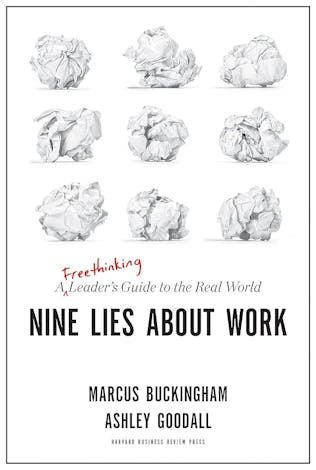

Nine Lies About Work: A Freethinking Leader's Guide to the Real World
By Marcus Buckingham & Ashley Goodall
Harvard Business Review Press, 2019
Publisher's summary
You crave feedback. Your organization's culture is the key to its success. Strategic planning is essential. Your competencies should be measured and your weaknesses shored up. Leadership is a thing. These may sound like basic truths of our work lives today. But actually, they're lies. As strengths guru and bestselling author Marcus Buckingham and Cisco Leadership and Team Intelligence head Ashley Goodall show in this provocative, inspiring book, there are some big lies — distortions, faulty assumptions, wrong thinking — that we encounter every time we show up for work. Nine lies, to be exact. They cause dysfunction and frustration, ultimately resulting in workplaces that are a pale shadow of what they could be.
But there are those who can get past the lies and discover what's real. These freethinking leaders recognize the power and beauty of our individual uniqueness. They know that emergent patterns are more valuable than received wisdom and that evidence is more powerful than dogma. With engaging stories and incisive analysis, the authors reveal the essential truths that such freethinking leaders will recognize immediately: that it is the strength and cohesiveness of your team, not your company's culture, that matter most; that we should focus less on top-down planning and more on giving our people reliable, real-time intelligence; that rather than trying to align people's goals we should strive to align people's sense of purpose and meaning; that people don't want constant feedback, they want helpful attention.
This is the real world of work, as it is and as it should be. Nine Lies About Work reveals the few core truths that will help you show just how good you are to those who truly rely on you.

In the spirit of cutting to the chase, here are the nine statements our authors deem “lies:”
The Nine “Lies”
- People care which company they work for.
- The best plan wins.
- The best companies cascade goals.
- The best people are well-rounded.
- People need feedback.
- People can reliably rate other people.
- People have potential.
- Work-life balance matters most.
- Leadership is a thing.
And here, in turn, are the two half-truths I will proceed to tell about this book:
- These “lies” are actually true.
- The authors have fascinating positive insights, but the list of “lies” obscures them.
Half-Truth #1: These “lies” are actually true.
As I indicate by labeling this a half-truth, I don’t entirely mean this assertion. Some of the lies are true, but some of the lies really are lies.
It really is the case, for example, that “the best plan” (lie #2) isn’t enough to win. In a fast-paced world, plans specific enough to deserve the label are outdated by the time the ink is dry. As Buckingham & Goodall write, “We aren’t planning for the future, we’re planning for the near-term past.” Their replacement for planning — systems of intelligence that liberate information and empower teams to act on it in real time — is a straightforwardly better approach and an eminently actionable insight.
Similarly, the authors are extremely persuasive that lie #4, “The best people are well-rounded,” is legitimately balderdash. They make a magnificent case that the best people, in all sorts of domains, are “spiky” — wildly strong in their strengths, and often mediocre to lacking in other areas. Leaders would be wise not to expect everyone to even try to excel at everything, and try rather to lean into everyone’s strengths and build a team of people doing what needs to be done by spending most (if not all) of their time activating and developing their strengths.
But in many other cases, the purported “lies” are, even granting the authors’ arguments, simply true, and can only be spun as lies by interpreting them in a strawmannish manner.
For one example, take lie #5, “People need feedback.”Is that a lie? Well, that depends, of course, on what you mean by “feedback,” and the authors make sure to explain that they mean it in a non-obvious, specific, and skewed way. When they get into the details, it emerges that what they’re talking about is negative feedback, whereas “Positive attention… is thirty times more powerful than negative attention in creating high performance on a team… ” It’s great to learn — and the authors quite convincingly show — the importance of positive feedback. But that’s not, in any way, an argument against “feedback” per se, just a cri de coeur about what kind is best.
For another example, take #10, “Leadership is a thing.” Buckingham & Goodall frame the existence of leadership as their target, but its existence isn’t what they attack. Instead, they attack leadership’s scarcity and difficulty to teach. “The fact that we lionize those who have this special ability; the fact that we spend so much time looking for it and trying to get more of it; and the fact that is plays such a prominent role in how we think about our organizations: these point not to its ubiquity but to its scarcity — and this scarcity, in turn, belies the supposed ease with which we’re all meant to be able to get better at it.” In my copy of the book, I underlined “the supposed ease with which we’re all meant to be able to get better at it” and scrawled in the margin, “Who ever promised you that?”
Buckingham & Goodall go on to explain that the greatest leaders, like all high achievers, exhibit many and varied mixes of strengths and weaknesses, reflecting many different ways of effectively leading, and they conclude that the only way to apprehend or define leadership is the following: “a leader is someone who has followers, plain and simple. The only determinant of whether anyone is leading is whether anyone else is following.” That’s a perfectly valid and useful observation. It is also a definition of leadership — a statement about what leadership is, as a thing. They’ve proven their supposed “lie” to be true. They apparently don’t even believe that leadership is not “a thing,” they just think it’s a thing about which many people have misconceptions. And those misconceptions, along with the authors’ prescribed alternatives, may be (and are!) quite valuable to explore — it just makes the frame of debunking a “lie” about the very existence of leadership a bit distracting and off-putting, at least to this reader.
And that brings us to my second half-truth.
Half-Truth #2: The authors have fascinating positive insights, but the list of “lies” obscures them.
Is it odd that I have framed my review of this book in the form of two half-truths instead of a more straightforward evaluation of what I think the authors get right and wrong? Does this format run afoul, even, of Leading Edge’s usual tone of positivity?
Good. Because that’s my point. By framing everything as being about confronting lies, this book half-buries the many incredibly good and positive ideas you can find in this book.
Here are just a few of the ideas I personally found most valuable:
- On engagement: In chapter 1, “People Care Which Company They Work For,” the authors share some well-validated metrics that predict sustained team performance (hint: they match up amazingly well with Leading Edge’s definition of employee engagement).
- On the importance of the smaller team experience within organizations: “Experience varies more within a company than between companies… When people choose not to work somewhere, the somewhere isn’t a company, it’s a team.”
- On the downsides of goals: “The very best salespeople hit their quota months before the end of the year, whereupon… they start to delay the closing of their deals so that they can ‘bank’ them and ensure that they begin the next year with a head start. Sales goals actually degrade the performance of top salespeople”.
- On strengths: “The single most powerful predictor of a team’s productivity… is each team member’s sense that ‘I have the chance to use my strengths every day at work.’”
- On rating: “Although we are not reliable raters of others, people can reliably rate their own experience.”
These are just a smattering of the many quotes I have marked with little book flags in my copy of this book. With so many beautiful flowers to share, did the authors really need to package them in thorns? Indeed, at the very end of the book, they go ahead and frame what they wanted to say in positive form, as nine truths:
The Nine Truths
- People care which team they’re on.
- The best intelligence wins.
- The best companies cascade meaning.
- The best people are spiky.
- People need attention.
- People can reliably rate their own experience.
- People have momentum.
- Love-in-work matters most.
- We follow spikes.
I would like to think (without knowing the truth) that this positive list is what the authors originally brought to their agent or publisher, and that perhaps it was someone on the publishing end of things who convinced them to reframe the whole thing as being about lies, because conflict sells.
Look, I’m a communications professional, so I get it; it’s hard to get attention. If you’re reading this post, you probably don’t pick strawberries or mine coal for a living — you’re probably a knowledge worker, and in knowledge work, attention is the coin of the realm. Sometimes it’s tempting to do whatever it takes to get that next hit of attention; to exaggerate or sensationalize, just a bit, so that people will pay attention to the good idea you’ve got.
Yet, I aver, there are more and less honest, and more and less distracting, ways to send up a signal flare. I tend to think people and organizations would do well to keep our attention-grabbing language well aligned with the most reasonable readings of the realities we’re talking about.
A full truth: This is a good book, and worth reading.
My critique, such as it is, is about the framing of this book — the title, the chapter titles, and a little more verbal scaffolding around the edges. But don’t let that put you off. Inside the frame, this picture rewards examination. Nine Lies About Work is a valuable read for managers, leaders, talent professionals, and anyone else in the People Business.
As the book itself would recommend, we as readers should focus less on its shortcomings and more on its very real strengths.
About the Author

Seth Chalmer is Vice President, Communications at Leading Edge.
Loading footer...


